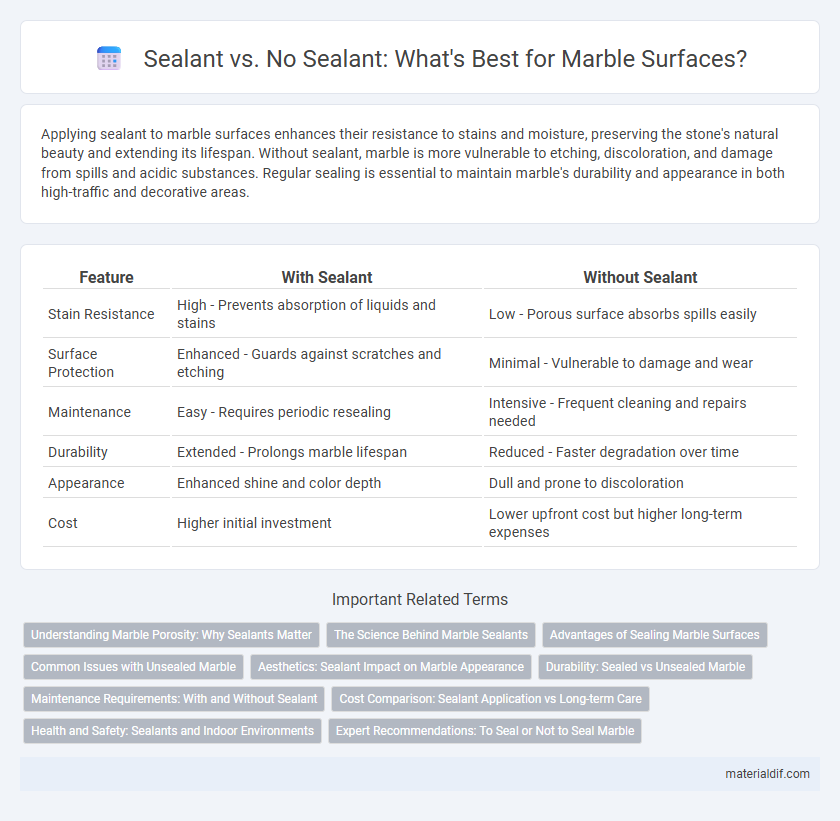Applying sealant to marble surfaces enhances their resistance to stains and moisture, preserving the stone's natural beauty and extending its lifespan. Without sealant, marble is more vulnerable to etching, discoloration, and damage from spills and acidic substances. Regular sealing is essential to maintain marble's durability and appearance in both high-traffic and decorative areas.
Table of Comparison
| Feature | With Sealant | Without Sealant |
|---|---|---|
| Stain Resistance | High - Prevents absorption of liquids and stains | Low - Porous surface absorbs spills easily |
| Surface Protection | Enhanced - Guards against scratches and etching | Minimal - Vulnerable to damage and wear |
| Maintenance | Easy - Requires periodic resealing | Intensive - Frequent cleaning and repairs needed |
| Durability | Extended - Prolongs marble lifespan | Reduced - Faster degradation over time |
| Appearance | Enhanced shine and color depth | Dull and prone to discoloration |
| Cost | Higher initial investment | Lower upfront cost but higher long-term expenses |
Understanding Marble Porosity: Why Sealants Matter
Marble porosity significantly affects its susceptibility to staining and moisture damage, making sealants essential for protection. Sealants penetrate the marble's microscopic pores, creating a barrier that reduces liquid absorption and preserves the stone's natural appearance. Without sealant, marble is more prone to etching, discoloration, and surface degradation due to its porous structure.
The Science Behind Marble Sealants
Marble sealants chemically penetrate the porous surface, creating a protective barrier that reduces water absorption and prevents staining by blocking contaminants at the molecular level. Sealed marble maintains its structural integrity and appearance longer by minimizing the effects of acids, oils, and environmental pollutants that typically cause etching and discoloration. Without sealant, marble remains vulnerable to moisture infiltration and surface damage, accelerating wear and necessitating more frequent maintenance and restoration.
Advantages of Sealing Marble Surfaces
Sealing marble surfaces protects against stains, moisture infiltration, and etching from acidic substances, preserving the stone's natural beauty and durability. The sealant forms a protective barrier that reduces the need for frequent cleaning and maintenance, extending the lifespan of marble countertops, floors, and walls. This treatment also enhances resistance to mold and mildew growth, making sealed marble an ideal choice for kitchens and bathrooms.
Common Issues with Unsealed Marble
Unsealed marble is prone to staining, etching, and water damage due to its porous nature, allowing liquids and oils to penetrate quickly. Common issues include discoloration from spills, surface dullness from acidic substances, and increased susceptibility to mold and mildew in damp environments. Applying a high-quality sealant helps protect the marble by creating a barrier that repels contaminants and preserves its natural beauty.
Aesthetics: Sealant Impact on Marble Appearance
Applying a sealant on marble enhances its natural shine and depth, preserving the stone's vibrant veining and rich color over time. Without sealant, marble is prone to dullness, staining, and surface etching, which can compromise its visual appeal and reduce its luxurious aesthetic. Sealants create a protective barrier that maintains the marble's polished finish, ensuring long-lasting beauty and an elegant look.
Durability: Sealed vs Unsealed Marble
Sealed marble offers enhanced durability by providing a protective barrier against stains, scratches, and moisture, significantly reducing surface damage and prolonging the stone's lifespan. Unsealed marble is more susceptible to etching, staining, and wear from daily use, which can lead to costly repairs and a diminished aesthetic over time. Applying a high-quality sealant ensures long-term preservation of marble's natural beauty and structural integrity, making it a cost-effective choice for maintaining durability.
Maintenance Requirements: With and Without Sealant
Marble with sealant requires less frequent cleaning and is more resistant to stains, scratches, and moisture, significantly reducing long-term maintenance efforts. Without sealant, marble surfaces are more prone to discoloration, etching, and damage from spills, necessitating regular deep cleaning and prompt spill management to preserve its appearance. Properly sealed marble can maintain its natural sheen and durability with only periodic reapplication of the sealant every 6 to 12 months.
Cost Comparison: Sealant Application vs Long-term Care
Applying sealant on marble surfaces involves an initial cost ranging from $5 to $15 per square foot, which protects against stains and reduces the frequency of deep cleaning or repairs. Without sealant, maintenance expenses increase over time due to frequent polishing, stain removal, and potential surface damage, leading to higher cumulative costs. Long-term care without sealant can exceed initial application costs by 30% to 50%, making sealant a cost-effective investment for marble preservation.
Health and Safety: Sealants and Indoor Environments
Sealants applied on marble surfaces significantly reduce the absorption of liquids and harmful contaminants, minimizing the risk of mold and bacteria growth that can compromise indoor air quality. Without sealants, marble's porous nature allows for the accumulation of allergens and pathogens, potentially causing respiratory issues and allergic reactions in occupants. Using sealants enhances the health and safety of indoor environments by creating a hygienic barrier that supports easier cleaning and maintenance.
Expert Recommendations: To Seal or Not to Seal Marble
Experts widely recommend sealing marble to enhance its durability and resistance against stains and moisture. Sealants create a protective barrier that helps maintain the stone's natural beauty by preventing etching and discoloration caused by acidic substances. Without sealing, marble is more vulnerable to damage, leading to costly repairs and reduced lifespan.
Sealant vs No sealant Infographic

 materialdif.com
materialdif.com